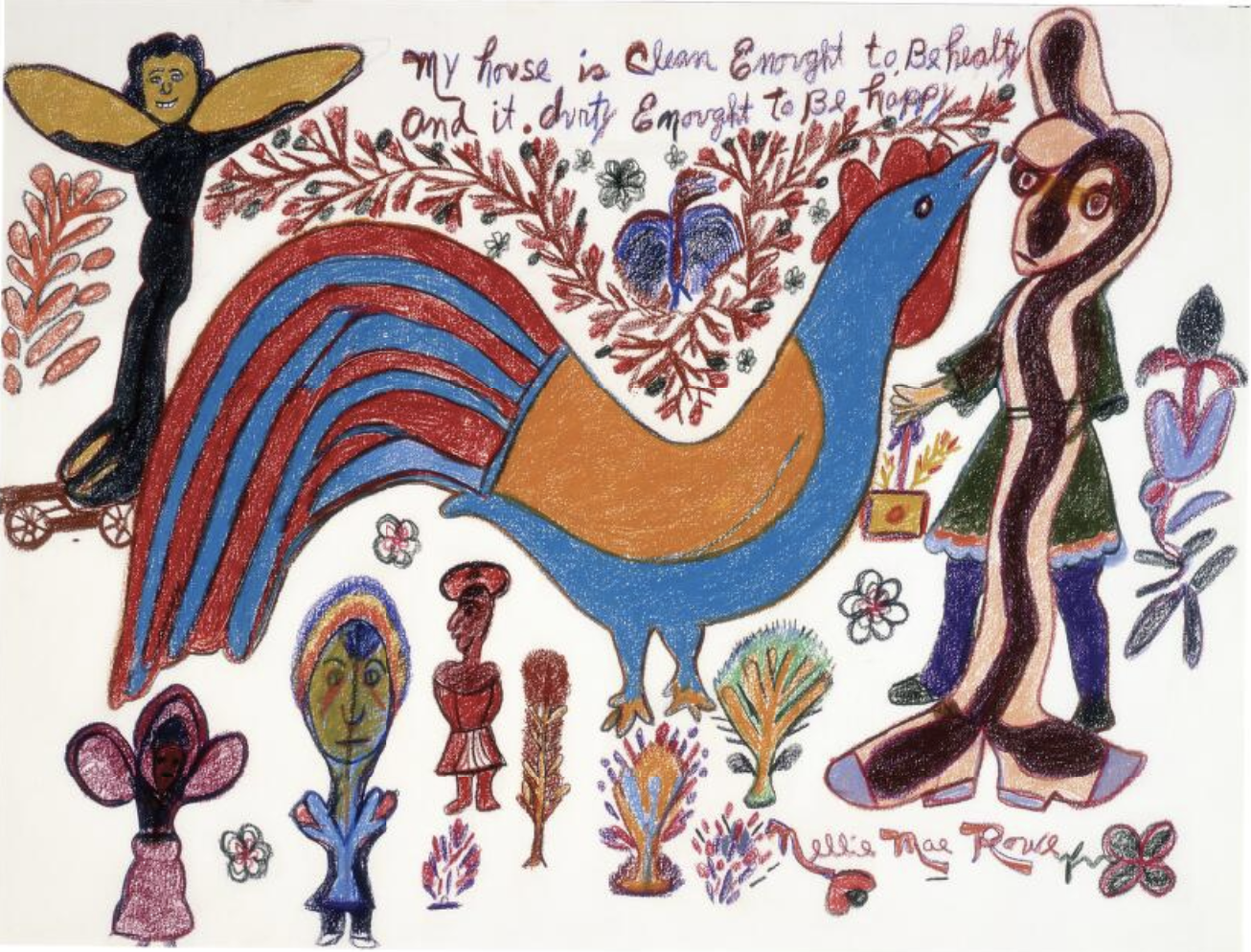Rowe Exhibition . Press
Atlanta Journal-Constitution (AJC) article by Bo Emerson
May 18, 2021
Nellie Mae Rowe, Atlanta visionary artist, in High Museum of Art show
Self-taught creator from Vinings gets first comprehensive exhibit in two decades
A major show of work by Atlanta artist Nellie Mae Rowe will be staged at the High Museum this fall. It will include "My House is Clean Enough," a drawing that expresses a feeling familiar to anyone who has had their fill of housework. Courtesy of High Museum of Art
By Bo Emerson
May 18, 2021
When passersby in sleepy Vinings saw Nellie Mae Rowe’s decorated yard, packed with handmade dolls and chewing gum sculptures and beads and wigs hanging from trees, they didn’t know what to make of it.
Some gawked. Some thought she was a “hoodoo” woman or a fortune teller. Some pitched bottles through her windows and broke her flower pots. She met all responses with poise.
Those who threw missiles, she invited in to see her yard and her “playhouse.” “I don’t like to be mean,” she told interviewer Judith Alexander Augustine in 1971. “I like to do good ‘cause you got to die one day.” You can’t go to heaven, she said, being mean.
Her guestbook was signed by more than 800 people who had toured her house and gardens just from May 1973 to March 1975. Hundreds more would follow.
Nellie Mae Rowe was one of Atlanta's most noted self-taught artists. Her show will include this allegorical work, "Angel and Devil's Boot." Courtesy of High Museum of Art
By the beginning of the 1980s things had changed for Nellie Mae Rowe. Her artwork was being sought by museums and collectors. She was honored in one-woman shows at Spelman College and at the Knoxville World’s Fair, and, in 1979, at the Parsons-Dreyfus Gallery in New York. She died in 1982, at the peak of her career.
Atlanta artist and curator Xenia Zed, who knew Rowe and visited her house, said Rowe’s calm acceptance of her change in status was telling.
Whether pelted at her home or celebrated on the stage at Symphony Hall, she was unshakeable in her self-confidence, said Zed.
“I believe that Nellie Mae Rowe completely and totally believed in herself, and she is an example for us all to be inspired by for that reason,” said Zed. Rowe’s attitude, she said, was “Go on and throw things through my windows. I’ll take them and put them in my garden, ‘cause I know what I’m doing, I know what I want to do and I know what I want to say.”
Nellie Mae Rowe called her Vinings home her "Playhouse" and turned it into an art environment, inside and out. Courtesy of Melinda Blauvelt
Nellie Mae Rowe, the visionary artist, born on a farm in Fayetteville on July 4, 1900, will be celebrated this fall in a major show at the High Museum of Art, called “Really Free: The Radical Art of Nellie Mae Rowe.”
“She’s somebody who was radical,” said Katherine Jentleson, the High’s curator of folk and self-taught art. Rowe was radical, not just because she put her art where it couldn’t be ignored, and demanded to be seen, said Jentleson, but because she invited hundreds of her neighbors to come see it.
“She was so sure she had something to share, and had this confidence in her artistic genius, and she believed in God and believed he would protect her,” she said.
The show will include about 60 pieces by Rowe, including works on paper, sculptures and dolls, along with photos of her work and life by Lucinda Bunnen, Melinda Blauvelt and others.
It is the most significant presentation of Rowe’s art in two decades, and is focused on how Rowe’s art was, itself, an act of bravery, cloaked in a spirit of joy and playfulness.
Jentleson speaks of how unusual it was for a Black woman and a self-taught artist to gain respect and visibility at that time and also of Rowe’s sometimes-submerged messages.
Today gallerists and collectors are enraptured by Rowe’s wild colors, her Chagall-like floating figures and fanciful creatures.
In the crayon and colored pencil work “Pig on the Freeway,” for example, Rowe places a stolid brown porker motionless on a swirl of multi-colored lanes that call to mind I-285 and Frank Stella.
The image is pleasing and amusing. But it also tells the story of the urban sprawl that was annihilating Rowe’s peaceful neighborhood, as the new 10-lane beltway pushed through Vinings within sight of her yard.
Rowe’s five-room house was razed shortly after her death in 1982, her garden obliterated and her property became the site of an Indigo Hotel.
The makers of a new documentary film about Rowe, “This World is Not My Own,” will try to recreate that Playhouse using photographs and videotape from the era. The New York production company, Opendox, has built a scale-model of Rowe’s house, full of miniature objects, which they’re using, with animation, to tell the story of the artist. Sets and footage from that movie will be part of the show at the High.
Rowe was the ninth of 10 children born to Sam and Louella Williams. Her father was born into slavery; her mother was born shortly after the Emancipation Proclamation.
Sam Williams rented a small farm outside Fayetteville, and made a living growing cotton and produce, tending livestock, weaving baskets and operating his own syrup mill.
Nellie Mae left home as a teenager to marry Ben Wheat and to escape the onerous chores on the farm. They moved to Vinings, which had a population of only a few hundred at the time. Wheat died after an accident at a sawmill in 1936, and Nellie Mae married an older man named Henry Rowe.
Henry Rowe died in 1948. Nellie Mae continued to work as a domestic for a nearby white family named Smith, but when both Smiths died in the 1960s, Nellie Mae Rowe began to devote herself to her art.
Some of her work was featured in a show called “Missing Pieces: Georgia Folk Art 1770-1976,” staged at the Atlanta History Center, but it wasn’t until 1978 that one of her dolls, on display at the Nexus artists cooperative, caught the eye of gallerist and dealer Judith Alexander.
Thereafter Alexander gave almost all her attention to Rowe. “She felt she saw genius in Nellie Mae Rowe,” said Alexander’s cousin Judith Alexander Augustine.
As a college student at Boston University, Augustine visited Rowe during the summer and completed an interview and photo essay about her for a school project. Today she is the director of the Judith Alexander Foundation, which seeks to help Georgia artists, and focuses on Rowe.
Alexander brought Rowe to local and national attention, and organized the 1979 show at the Parsons-Dreyfus Gallery in New York, which Rowe attended, along with Augustine and photographer Lucinda Bunnen.
It was Rowe’s first trip out of Georgia and her first airplane ride, captured in black-and-white photos by Bunnen.
In 2003, the year before she died, Alexander gave the High Museum 130 works by Rowe. That gift was augmented this year when High supporters Harvie and Charles Abney gave the museum 47 works by self-taught artists, including 17 by Rowe. Many of those will be in the new show.
Support from the Art Bridges Foundation will allow the exhibit to travel to other museums through 2023. The pieces are all drawn from the High’s deep collection of Rowe’s work, and will shed new light on an artist whose playful nature masked a serious, revolutionary spirit.




